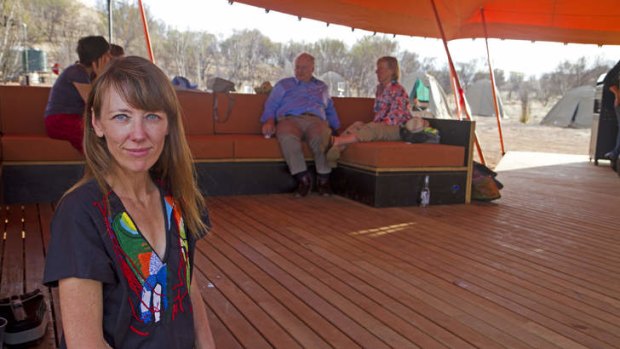
Architect Rachel Neeson, Nick Murcutt's widow, at the camp.Credit: Andrew Bain
After a tough trek along the Larapinta Trail, Andrew Bain enjoys the comforts of two very special new campsites.
On the slopes of the West MacDonnell Ranges, near Serpentine Gorge, views come easily. Scrub and spinifex grow sparsely along the quartzite ridges and termite mounds rise no higher than my hips. Nothing obstructs the view but the view itself - the lines of mountains that ripple away into a desert horizon.
I'm midway along the Larapinta Trail, the 223-kilometre walking track that stretches the length of the West MacDonnell Ranges, from the Alice Springs Telegraph Station to the summit of Mount Sonder. From the entrance to Serpentine Gorge it's a steep climb to the line of the ridge, and my steps are as slow as my breath is quick. The effort is worth every stride, for the best of the views - the Larapinta Trail's signature view - is now just a couple of hours ahead, at Counts Point.
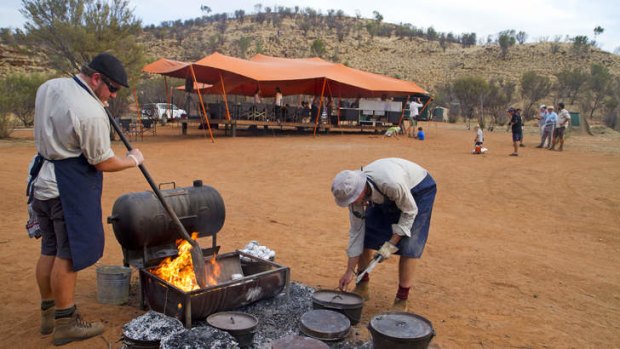
Nick Murcutt Camp.
From here, at the tip of the ridge, the scene unrolls all the way to Mount Sonder, about a week of walking away. Ghost gums paint white streaks into the red desert soil below, and gorges and waterholes slice the mountains into neat sections.
It's a landscape that's inspired artists - this was Albert Namatjira's country - and now also architects. At the foot of the ranges, after nine years in negotiation and planning with national parks authorities and the traditional Arrernte owners, trekking operator World Expeditions have opened two architecturally designed semi-permanent campsites for Larapinta hikers.
The Charlie Holmes Camp, named after one of the Larapinta Trail's pioneer guides, is almost immediately below me as I stand on Counts Point. Near the site of a failed tourist resort from the 1950s, it's cradled between spinifex-covered hills that provide ideal vantage points to watch the setting and rising sun.
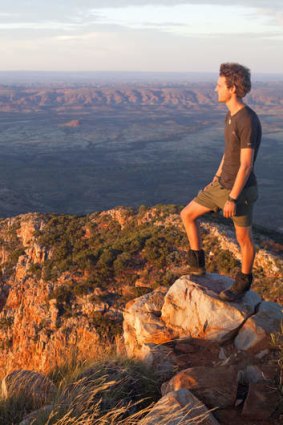
Mt Sonder.Credit: Andrew Bain
For trekkers, this camp - and the second camp near Simpsons Gap - is now as welcome as any resort. The camp is framed around a central, open communal tent shading an elevated, Y-shaped platform with separate arms for the kitchen, dining and lounge areas, and a campfire positioned in the dirt between the two living areas.
Its design was inspired by Arnhem Land sleeping platforms and Bedouin tents, as well as a walk along the Larapinta Trail in 2005 by its architects, Rachel Neeson and husband Nick Murcutt, who worked collaboratively on the design until Nick - son of the great Glenn Murcutt - died in 2011, aged 46, midway through the project. The camp near Simpsons Gap has been named the Nick Murcutt Camp.
"The thing Nick loved about camping was its elemental quality, and there's definitely more of Nick [than me] in this project, because the camping element came by Nick," Neeson says. "I love swag camping now, but that love came through Nick.
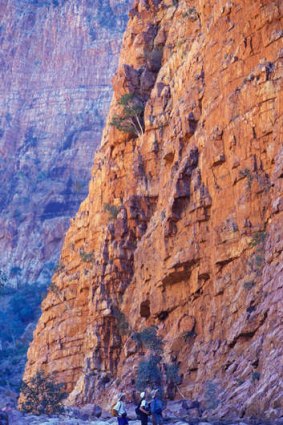
Ormiston Gorge.Credit: Alamy
"Essentially the idea was to bring an element of comfort without taking away at all the fact that you're camping. We wanted it to be true to the idea of camping. You want people to be able to do the trek and come here and feel like they really have camped."
In this fragile desert ecosystem, sustainability is also a keystone of the camps. Both have waterless composting toilets, while grey water from the hot showers and the kitchen sinks is trapped, filtered and run through absorption trenches to an evaporation point.
Cardboard waste is taken away, crushed into briquettes and used as fuel on the campfire, while camp lighting (and USB and 12-volt chargers built into the frame of the communal tent) is powered by a solar panel.
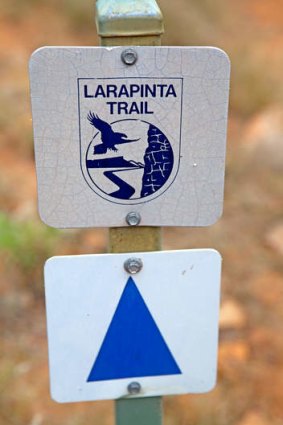
Follow the trail markers.Credit: Alamy
The Bedouin-style tent canopy is made from a stretch fabric that allows it to be adjusted according to weather conditions.
"This is quite incredible stretch fabric, so only the two centre poles are vertical and in footings," Neeson says. "The outer poles are on swivel bases, so they can move around.
"The idea is that you can pull on the guy ropes and pull the whole structure to one side or the other. You can pull the side down so that if it's windy, you can get a bit of wind protection."
It's not luxury and it's not glamping, with hikers sleeping in swags atop stretcher beds in two-person tents dotted around the campsite. But it is a step up from the traditional dirt-and-dust camping experience.
"One of the things we know is that there's a strong emergence of travellers who like higher comfort levels," World Expeditions chief executive Sue Badyari says. "They like walking - they'll go hard during the day - but they do like creature comforts at night, and if we can provide something that's really sustainable and environmentally responsible, I think that has great charm for those people."
If the camps help to cushion the desert nights, the days offer no such softener. There's hard ground to be covered, and the only way to do that is to walk, often through heat, spinifex and clouds of flies. It's a small price to pay for the reward of this most personal of outback experiences.
In the 11 years since its completion, the Larapinta Trail has become one of Australia's most famous long-distance trails, bringing the outback and the red centre into the practical reach of hikers.
The trail is divided into 13 sections, with water sources and waterholes sprinkled along its length. From the semi-permanent camps, which will be stripped back to their framework at the end of each winter season, hikers on three- and six-day trips radiate out onto highlight sections of the trail. Days are spent wandering through the likes of narrow Standley Chasm, the multicoloured Ochre Pits, cycad-filled Inhalanga Pass, Ormiston Gorge, and the final ascent to the summit of Mount Sonder.
Walk almost anywhere along the western half of the Larapinta Trail and this most striking of West MacDonnells' peaks rules the view. If you're walking east, away from the mountain, its constant presence seems almost to mock your lack of progress.
It's known locally as the Sleeping Woman for its obvious shape, though at 3am when we begin walking from Redbank Gorge at its foot, it might as well have no shape. The darkness is almost pure, sprinkled only with stars and the lights of our head torches. Below us, the torches of a pair of other hikers bob about like fireflies.
For three hours we walk through darkness, with only the effort in our legs translating the unseen terrain into a mountain. As the cloud begins to glow with dawn colour, we finally rise onto the summit.
Around us, the desert tones and the desert air both slowly warm as the rising sun pulls the curtain back on some of the red centre's finest natural features: Mt Zeil, the Northern Territory's highest peak; the meteorite impact crater of Gosses Bluff; the dry, snaking line of the Finke River, sometimes touted as the world's oldest river, breaking through the range at Glen Helen Gorge; and the gleam of distant salt lakes.
Somewhere far to the east, among the straight lines of the ranges, Counts Point stares back at us, making this a view of a view, though it somehow gets better with each look.
Andrew Bain travelled courtesy of World Expeditions and Tourism NT.
TRAILBLAZING: FIVE HIGHLIGHTS
Standley Chasm Climb above the famous slot for a view deep into the gorge, or head into the chasm to be engulfed by the West MacDonnells.
Section 5 Sixteen kilometres of pure mountain joy, balancing atop sharp, rocky ridges and descending into remote Hugh Gorge.
Counts Point Exceptional views along the line of the West MacDonnells to Glen Helen Gorge, the mouth of Ormiston Gorge and Mount Sonder.
Desert dips This is no parched desert walk — savour day's-end swims at the likes of Glen Helen Gorge and Serpentine Chalet Dam.
Dawn on Mount Sonder Climb the West MacDonnells' most prominent mountain to end your hike in the beauty of sunrise.
FAST FACTS
Getting there Qantas flies daily to Alice Springs from both Sydney and Melbourne, while Tiger Airways has four flights a week from each city. See qantas.com.au; tigerairways.com.
Hiking there World Expeditions offers a range of trips on the Larapinta Trail. Hikers on the three-day Larapinta Experience ($1095) and the six-day Classic Larapinta Trek ($2195) stay in the new semi-permanent campsites each night. The Larapinta End to End ($3490) involves 14 days of walking from Alice Springs to Mount Sonder.
Fitness and gear A moderate level of fitness is a minimum requirement on the Larapinta Trail as hiking days can exceed 20 kilometres, often in hot conditions. The heat and the hard quartzite ground are tough on feet, so bring good hiking shoes or boots and be alert to hotspots that can lead to blisters.
More information larapintatrail.com.au;worldexpeditions.com.au; travelnt.com
Sign up for the Traveller Deals newsletter
Get exclusive travel deals delivered straight to your inbox. Sign up now.